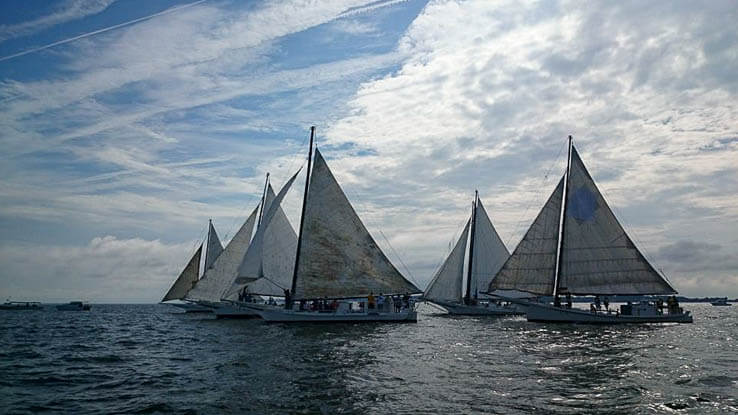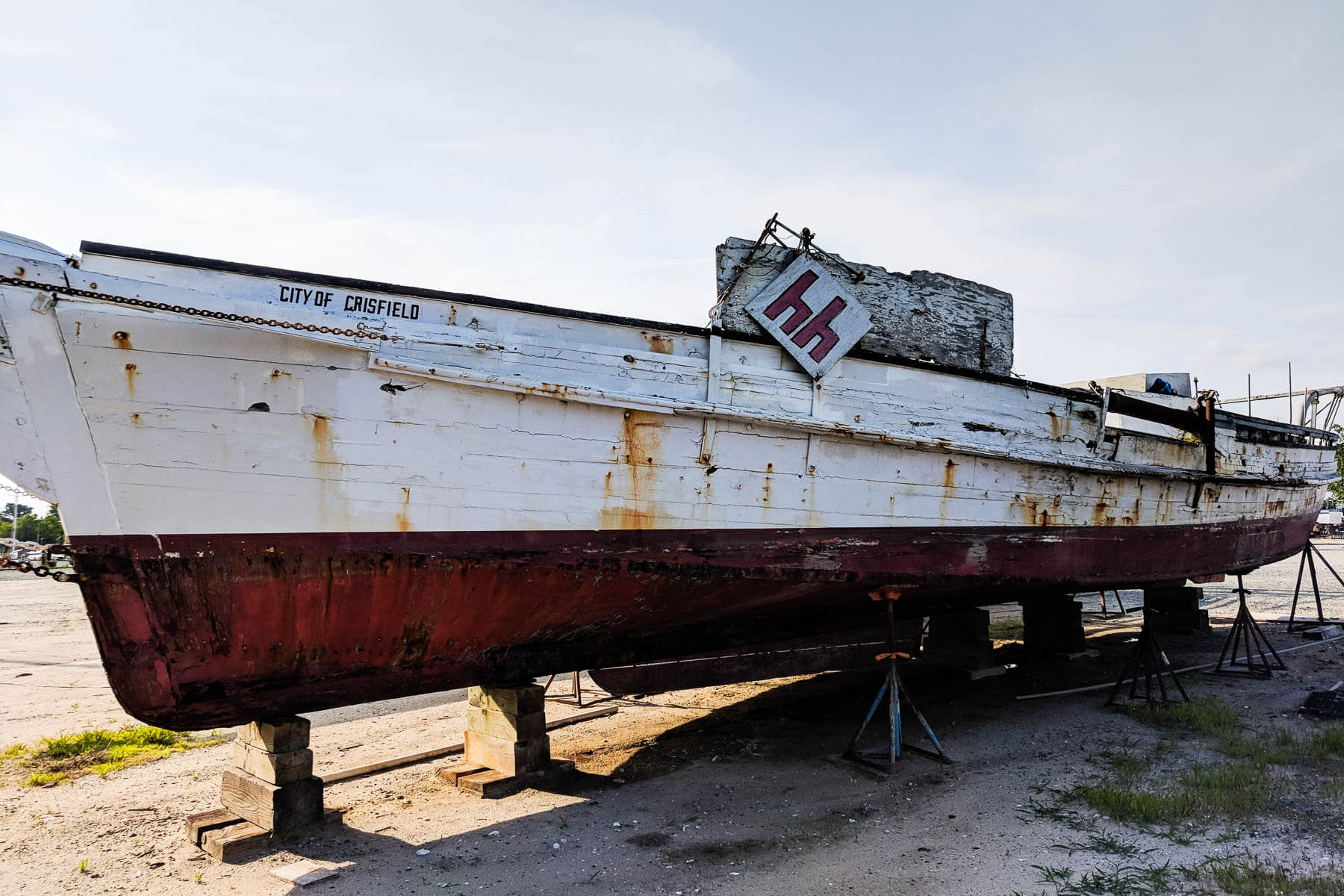Portrait of an Island Part II: What binds us together
This is the second installment of a three-part series on Deal Island, Maryland. Read the first installment.
At the end of Eldon Willing Road in a Deal Island harbor, past patches of forest and houses that have seen better years, sits an unremarkable, low building in Scotts Cove Marina with little sign of welcome. On the ground, oyster shells mingle with rivulets of sand and workboats fill the harbor slips. Up on the land, a very old skipjack grows bright green weeds from its wooden planks. The marina landscape would seem to reinforce the idea of a shrinking waterman community, but a step through the shop door tells a livelier story.
“What do you say, Captain!” That’s Jack Willing, the proprietor of Scotts Cove and a man well known in the boating world even off the island. He is telling stories and continuously interrupting them to greet every waterman who enters the shop, which happens often. Willing is an accomplished shipbuilder, one who spent years flying the world to service the watercraft of the rich and famous. These days, he is home on Deal Island and unashamedly happy about it. For a man so extensively traveled and with the skills to go anywhere, what is so special about Deal Island?
“There’s nothing like it,” Willing states promptly. “Everybody knows who everybody is. That’s what I like about here. You know everybody and if you need help, they give you help.”
It is more than land that will be lost as the Chesapeake changes—the deep community ties of Deal Island are not found in many areas.

Community life
The Deal Island Wildlife Management Area, 13,000 acres of tidal marsh and stretches of open water, separates Deal Island from the rest of civilization. Guts—narrow channels of water with strong currents that flow out to the main bay—snake their way through the marshes and the island proper.
There are four communities in Deal Island: Dames Quarter, Chance, Deal Island and Wenona. Dames Quarter is the first dry land you come to after traveling the long stretch of Route 363 through the marshes, with Chance just after on the mainland side of Deal Island. Wenona is the farthest edge of the island before you come to open bay. Where the road runs out at the water’s edge sits Arby’s general store, which is also the island’s only restaurant, bar and a bait shop.
Like many cultures, a glimpse of Deal Islands can be readily seen through its food. I grew up on Deal Island visiting my family, and our Thanksgivings were the mixture of southern and water cultures that is unique to the Eastern Shore—or perhaps just to the Tangier Sound. I was a teenager before I realized most of the country thinks of dumplings as puffed pastries, rather than the gravy-slathered slick dumplings of island Thanksgivings. We ate steamed crabs in the days before Thanksgiving while doing the preparations, compliments of the Chesapeake Bay and my waterman cousin. Cheesy crab dip sat next to the mashed potatoes and collard greens, and oyster fritters were as natural and necessary as the turkey. As for guests, it was impossible to tell from the way people were treated who was actually related and who was a friend or neighbor.
That’s what sets Deal Island apart, says resident Mary Frances Whitelock. “We look after each other.”
The average age on the island has started to creep up. When someone passes away, extra food, flowers and people are coordinated through the churches, fire companies, legions and other civic-minded organizations strongly established on the island. “It’s a community thing, the whole thing, from Dames Quarter right on down,” she states proudly.
Whitelock speaks from the deck of her home, which looks out over a large piece of property and a view of the workboats coming and going on the open bay. The beauty of this island could stop you in your tracks, yet it never seems to be the reason residents stay. “I like a community life,” she explains. “It’s quiet, but yet everybody’s here. If you need somebody, you call. Country life.”
In a waterman village where the oldest vessels are still made of wood, the boats themselves are often treated like members of the community. On Deal Island, this is especially true of the boat born on its shores: the skipjack.

Skipjacks and their people
As the oyster industry boomed in the late 1800s, skipjacks began to skim the waters. These shallow boats were ideal for skating over oyster beds in the Chesapeake Bay.
The skipjack is a carpenter’s boat, built on ratios rather than detailed plans. The overall size of the skipjack depended on the height of the trees—or in some cases, telephone poles—that were available. The width of the deck, or beam, is the same length as the bowsprit, the long piece that extends forward from the bow. The length of the deck equals the length of the boom, the wooden pole parallel to the water that holds the bottom of the sail. The height of the mast equals the length of the deck plus the beam. These ratios made skipjacks possible to build where they were needed, and they quickly filled the marinas of watermen communities like Deal Island.
Captains relied on the skipjacks for their livelihoods and came to know their boats well—they had to. Built of wood and faced with excellent conditions for rot in the marshy waters of the Chesapeake islands, skipjacks were carefully watched by their captains and continuously maintained to stay in working condition.
As oyster harvests declined, the waterman industry changed. Several skipjacks were pushed up into the mud to wait out the hard year in hopes of better numbers in the future. Many, like the Lorraine Rose, never made it out of the marshes.
Waterman Arthur Daniels, better known as “Daddy Art” to the community, was the longtime captain of the 1949-built skipjack City of Crisfield. He describes the waterman as “married” to the water, and his lifelong partner for that was his lady City of Crisfield. “I bought her in 1951 when I was thirty; she was two. We grew up together.”
Almost every area waterman learned part of the trade from Daniels, who worked the water for the better part of a century. Over the years, he developed a connection with the water that intertwined faith and came out in the poetry he would write while dredging.
“There’s something that lures you to it,” he would say about the water. “You fall in love with it and it becomes a part of your life.”
Daniels taught many how to work the water when they first started out; young people who worked their lives as watermen and are now retired in their own right. “My whole family is dependent on the water for livelihood. It's a way of life for them,” he once said in an interview. “Everybody on this island has been aboard this boat with me."
Captain Daniels dredged oysters on City of Crisfield until she was 65 and he was 93 years of age, when a stroke forced him into retirement. His eldest son, Stan Daniels, already well into his seventies, finished out the 2016 dredging season on City of Crisfield for his father.

Preserving a disappearing way of life
Today City of Crisfield no longer works the water; she is the boat growing weeds at Scotts Cove Marina. A heartfelt effort by the community is in the works for its restoration, but the financial costs—like those for starting out on your own to work the sea—are still too high.
About 30 skipjacks remain on the water, with scarcely a third still dredging. Each year, Deal Island holds the Skipjack Race and Festival around Labor Day as a chance for the community to honor their captains and history and for the area Lion’s Club to raise funds for the community.
The race and festival—which include a boat docking competition, a blessing of the fleet and a Miss Skipjack, Little Miss Skipjack and Little Mister Skipjack contest—give outsiders a glimpse into a culture that may not be around for much longer. The full Chesapeake Bay skipjack fleet, the last sail powered commercial fishing fleet in North America, is listed on the National Register of Historic Places. However, being nationally recognized as a part of living history does not guarantee survival nor restoration.
Deal Island’s culture is instead being preserved in the new Skipjack Heritage Museum and the stories and traditions passed down through the families and festivals. When the island itself has been reclaimed by the Bay, it is there that this waterman community’s culture and stories will persevere.
Read the third installment.
Note: Resident interviews were conducted jointly by Caitlyn Johnstone, Outreach Coordinator, and Will Parson, Multimedia Specialist. Mary Frances Whitelock is the author's grandmother.

Comments
So true, there is no place like Deal Island. I lived in Chance for a time then to south of Salisbury. My time on the shore was one of good memories. The people, the land, the water with putting them together brings out the soul of this country. To see the skipjacks and buildings being passed on to rot away brings sadness yet life moves on. The many photographs taken while there brings joy to having been there and having met those wonderful people. Thank you for writing about this great part of our country. Paul
Thank you!
Your comment has been received. Before it can be published, the comment will be reviewed by our team to ensure it adheres with our rules of engagement.
Back to recent stories